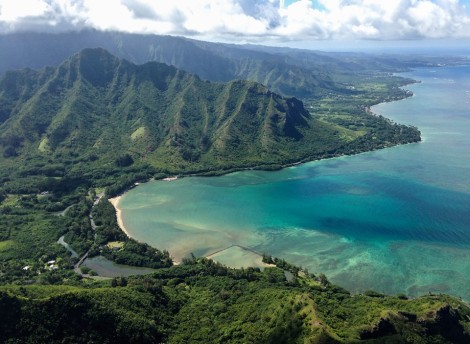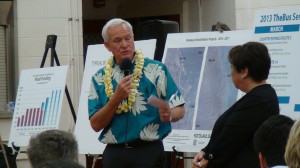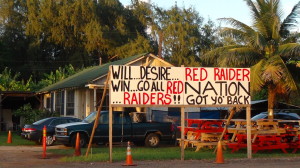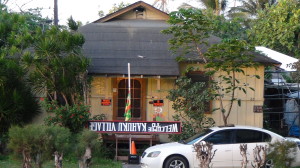“Keep the Country Country” — from Kahaluu to Haleiwa — is an integral part of needed diversity and versatility for a thriving and sustainable Oahu. This cause has never sounded so pragmatic and urgent for this iconic region as the first shoe of gentrification drops in Kahuku. It’s not about the past; it’s about the future.”
Tag Archives: Kahuku Plantation Camp
Choon James: Kahuku Plantation Camp – Eugenio Family Evicted and Home Razed Down
The complexion and neighborhood of Kahuku Plantation Camp continue to change
Continental Pacific, LLC from Florida purchased available land acreages, including the Kahuku Plantation Camp, from the Estate of James Campbell in 2006.
The gentrification of Oahu’s rural Kahuku Plantation Camp continues. About thirty-one (31) local families are facing evicting. The Eugenio Family home , next to the Kahuku Methodist Church, along Kamehameha Highway has been razed as of yesterday.
BEFORE
Today, the Kahuku Plantation Village of about 70 houses is in turmoil. Many are facing eviction from homes they’ve stayed in their entire lives. The sweat and equity of these inter-generational laborers; along with their heritage and roots are tied to this plantation camp.
What is occurring at the Kahuku Village Plantation Camp has happened elsewhere and can be quickly summarized in one word — “Gentrification”.
In a nutshell, gentrification is the compressed evolution of massive development in communities that produces “winners” and “losers.”
It’s obvious the “losers” are usually the less affluent.
Gentrification chases the less affluent out of their communities due to the influx of new money and spending power. The less affluent are unable to pay rising rents, property taxes, real estate and the accelerating costs of living. Local businesses may lose their leases under competition or have to keep up with newly built commercial spaces with higher built-in expenses. Development will provide short-term construction jobs to some but what happens next?
Gentrification can alter lifestyle, values, and identity of communities when left unchecked. It inevitably creates disconnect and conflicts in communities. In Hawaii, it’s become a volatile struggle to protecting the local culture and values, environment, finite resources, and a chosen island lifestyle that many hold dear.
Fortunately, Oahu has had a visionary General Plan since the 1970s under the leadership of then Gov. George Ariyoshi. Oahu was divided into eight different geographic areas, delineating different land-use policies that include Primary urban center (Honolulu), Secondary urban center (Kapolei), Urban – fringe (Koolauloa Poko), and Rural designations (Koolau Loa, North Shore, and Waianae).
This Oahu General Plan is a careful compromise to preserve what we hold hear about Hawaii and to address development.
To prevent urban sprawl and inevitable gentrification, decision makers must respect and adhere to the existing Oahu General Plan. There has to be a line of demarcation to safeguard viability and diversity in land-use decisions for Oahu. If we don’t stand for something, we’ll fall for anything.
This Oahu General Plan that protects the Koolau Loa and the North Shore’s charm of old Hawaii, finite resources, food security, watersheds, open space, recreational spaces, view planes, rural lifestyle, and especially the stability of kamaaina residents, must continue to be the basis for objective ‘Big Picture’ land-use planning. Decision makers must not allow big developers to hijack and amend this document to fit their own agenda.
“Keep the Country Country” — from Kahaluu to Haleiwa — is an integral part of needed diversity and versatility for a thriving and sustainable Oahu. This cause has never sounded so pragmatic and urgent for this iconic region as the first shoe of gentrification drops in Kahuku. It’s not about the past; it’s about the future.
Choon James: Mayor Kirk Caldwell’s “Town Hall Meeting” in Kahuku – a Dog and Pony Show
Mayor Kirk Caldwell’s “Town Hall Meeting” in Kahuku – a Dog and Pony Show:
First, the Press Releases about Mayor Kirk Caldwell’s “town hall meeting” from his office are dispersed to the various social media outlets:
“City Hall is coming to Ko’olauloa Nov. 19 when the mayor brings his cabinet to Kahuku High School cafeteria for a town hall meeting.
The event will run from 6 to 8 p.m. and is designed to address area residents’ concerns about road and sewer infrastructure, bus service, park maintenance and events, efforts to tackle the homelessness problem and more.
Mayor Kirk Caldwell and his department directors also will report on the administration’s priorities. The public is encouraged to participate and make suggestions.”
Jesse Broder Van Dyke
Communications Director
Honolulu Mayor Kirk Caldwell
Direct: (808) 768-6928
Cell: (808) 489-0341
The Kahuku Town Hall Meeting was met with a protest outside the Kahuku High School by citizens against Caldwell’s agenda to cement the Country. But the Mayor’s televised show did not disclose any of that.
About half of those in attendance were his cabinet members and city employees. The first four rows of the Kahuku High School cafeteria were occupied by his entourage who provided robust applause for the Mayor. The middle section of the cafeteria was occupied by more of the Mayor’s entourage, with some refreshments spread out on the table.
There were approximately 50 city employees. Others in attendance were recognized community activists and citizens. There was less than a handful of known Caldwell supporters. Steven Wheelwright – Brigham Young University-Hawaii President – and his wife were there for a short period. David Lewis, BYU-H Vice-President of Construction was a lone figure with his baby blue Envision Laie t-shirt. There were also policemen and several plainclothes policemen.
The Mayor used all the right words and pushed the right political buttons using his “Waipahu roots”, peppered with some pidginspeak, and he didn’t forget to remind the audience of his “compassion”. But his showmanship did not fool the astute citizens.
Marisa Yamane and Joe Moore from Khon 2 TV reported a more accurate description of what happened at the Town Hall meeting with Mayor Kirk Caldwell.
The meeting was tightly-controlled. There was no direct questioning. Those who wanted to “participate” had to write their questions on a piece of paper to be submitted to the mayor. They requested name, address and email address. There was no opportunity for clarifications or rebuttal during this promotional tour that was on the city’s dime.
Some found the music -“All Hawaii Stand Together” written by Uncle Liko Martin – used by Caldwell insulting and ironic. Mayor Kirk Caldwell has not met a development he does not like. Hawaiians are up in arms against the disappearance of their inheritances, aina, values and culture. Ko’olauloa is one of very last regions that has some semblance of local lifestyle.
Hawaii News Now Rick Daysog‘s reporting lacked objectivity, including the following:
“The mayor’s town hall meeting at Kahuku High School on Tuesday was well attended by groups both in favor and opposed to the Koolau Loa Sustainability plan.”
Reality: The mayor’s entourage made up half the attendance. There were less than a dozen Caldwell supporters. The rest were residents and Defend Oahu Coalition members who wanted an honest discussion, that never took place.
 Daysod interviewed former state lawmaker Bob Nakata who said, ” he supported the city’s transit-oriented development plan because it promised to confine large-scale construction to urban areas. But now he’s changing his mind.
Daysod interviewed former state lawmaker Bob Nakata who said, ” he supported the city’s transit-oriented development plan because it promised to confine large-scale construction to urban areas. But now he’s changing his mind.
“This Malaekahana development will make Laie and Kahuku one big urban area,” said Nakata.
Here are some grassroots reactions to the “Town Hall Meeting”:
Hauula Resident Joshua Noga: Mayor Town Hall Meeting More of a Campaign Stop. Last night Honolulu Mayor Kirk Caldwell came to Kahuku High School Cafeteria along with forty of his staff to meet with Ko’olau Loa residents in what he called a town hall meeting. The meeting was anything but a town hall meeting, but resembled more of a stop on his campaign trail. I have never been to a town hall meeting where the public were not able to express their concerns directly but was instead told to write their questions down on a piece of paper. The questions were hand picked by the mayor as to which he would answer and were then read aloud by a member of his staff.
Community members present watched in amazement as the mayor thumbed through questions, his face turned red with embarrassment as he looked for safe questions to answer. Let it be known that Mayor Caldwell supports an urbanization plan that looks to amend the Oahu General Plan, a plan that would violate native Hawaiian tenant rights of kuleana landholders, rezone state-districted Ag lands in Malaekahana, and rezone Laie as resort community like Waikiki. Let also be known that the Ko’olau Loa Hawaiian Civic, Waikane-Waiahole Community Association, Kaaawa Community Association, Friends of Kahana, Punalu’u Community, Hauula Community Association, and neighborhood boards from Manoa to Ewa oppose the urbanization of Ko’olau Loa currently known as Bill 47. Keep the Country COUNTRY!
Joshua Noga- Hauula, HI
Ko’olau Loa Hawaiian Civic Club
Ka’a’awa Resident: Andrea Peatmoss:
“The ‘presentations’ section was too long. Since our sole 2 lane Kamehameha Highway is a State road, the long pothole story was too long; and we won’t have much to do with Rail and only Laie has a sewer, ( still on federal consent decree that taxpayers now pay for it sounded like, but you couldn’t ask questions until after), a lot was largely irrelevant to most people.
Mayor Caldwell whizzed thru one Envision Laie question -again only a written question – and said nobody will be happy with the results, more or less. He focused on a Kahuku has such close ohana tradition plantation camp but too many generations in a house issue to Then you were to talk to the individual staff afterwards- which was difficult physically to stand around to do – and as you waited you couldn’t really hear if the person before you had just asked the same question of that person.
Kahuku Plantation Camp Robert Trotter: “When I approached our honorable mayor last night, he pulled his hand back, instead of out to shake my hand. First politican to not want to make the traditional move. I must have the look of a destitute homeless person. Besides the five or six uniformed police officers, there were at least seven or more very large undercover police roaming the meeting, giving poeple the look. There were more staff and caldwells people than others. he answered questions written down, but maybe 10 questions out of an easy 150 we the people delivered. A beauitful dog and pony show, but the dog was showing many large teeth.”
Kahuku Resident: Angela Huntemer: Thank you for filling us in on that – I couldn’t go and was wondering what happened. The week before he took direct questions from the audience at Waialua – because there were hardlly any members of the public. Glad I didn’t have to be the one to find easy questions for the mayor… that would have been difficult. Imua!
Hau’ula Resident Joshua Noga: Wow that makes this even more crazy. Caldwell and his staff should be embarrassed by that showing. To not even allow community members to express their concerns directly defeats the very purpose of having a town hall meeting. That’s why we have to call him out on his bs and hold him accountable.
We got white washed, and shoved under the pavement below the bus. Two topics bus, and pavement he spent some time on. Would have helped if the told the true factor, paving oahu the going rate in construction cost million dollars a mile.
Ka’a’awa Resident Andrea Peatmoss: I did not care for the format of it. The questions section needed to be open to all to ask and be answered instead of afterwards. Public content safe this way. No mention of the Ethics Commission investigation I thought he might defend himself or staff regarding either.
As for condemnation via eminent domain question, it was “absolutely the last resort ” he said. However, knowing how Choon James‘ property is being affected and Hau’ula lost its recycling center via eminent domain for a NEW fire station, I wonder. If we have $20 million, we have $20 million. Allocation is a City decision, right?
Now we have no recycle center and a temporary golf course owned by private (foreign ) investor in escrow and existing trauma in Kahuku Village of evictions. Kahuku had an ‘affordable’ housing plan years ago that never got built. Where did that money go? Between that project and the 550 residential units not built WITHIN Laie that have been approved for years but not built, the lack of sufficient dormitory housing on campus for students and the illegal Vacation Rentals by Owners (hundreds near Laie), we have a housing shortage that could be solved without destroying the scenic resources of the Moku and its irreplaceable wild coastline for URBAN SPRAWL. What cannot be solved without huge H-4 type money investment for taxpayers, way over the cost of Rail, is that extra traffic on the sole eroding 2 lane Kamehameha Highway that Turtle Bay Expansion and Envision Laie alone cause. Double the population. Add to that the expected increase in tourists to 7,500,000 (10,500 a day out here in Ko’olauLoa) and the thousands of already zoned vacant residential lands within the Moku. Do the math!
Andrea Peatmoss I did not care for the format of it. The questions section needed to be open to all to ask and be answered instead of afterwards. Public content safe this way. No mention of the Ethics Commission investigation I thought he might defend himself or staff regarding either. As for condemnation via eminent domain question, it was “absolutely the last resort ” he said.
However, knowing how Choon James’ property is being affected and Hau’ula lost its recycling center via eminent domain for a NEW fire station, I wonder. If we have $20 million , we have $20 million. Allocation is a City decision, right? Now we have no recycle center and a temporary golf course owned by private (foreign ) investor in escrow and existing trauma in Kahuku Village of evictions. Kahuku had an ‘affordable’ housing plan years ago that never got built. Where did that money go? Between that project and the 550 residential units not built WITHIN Laie that have been approved for years but not built, the lack of sufficient dormitory housing on campus for students and the illegal Vacation Rentals by Owners (hundreds near Laie), we have a housing shortage that could be solved without destroying the scenic resources of the Moku and its irreplaceable wild coastline for URBAN SPRAWL. What cannot be solved without huge H-4 type money investment for taxpayers, way over the cost of Rail, is that extra traffic on the sole eroding 2 lane Kamehameha Highway that Turtle Bay Expansion and Envision Laie alone cause. Double the population. Add to that the expected increase in tourists to 7,500,000 (10,500 a day out here in Ko’olauLoa) and the thousands of already zoned vacant residential lands within the Moku. Do the math!
Hau’ula kupuna Marvin Iseke: ” It was a waste of time. There was no open mike. This was no town hall meeting; it was his TV show. The Mayor was hiding behind his directors. The mayor talked about things we don’t need to hear and ran away from the important things we wanted to talk about.”
An observer from Kauai said: ” You guys are too nice.”
Ko’olau Loa residents in good faith took the time to attend the Mayor’s Town Hall Meeting to participate and engage in a thoughtful dialogue. They wanted meaty civic participation with the Mayor and offered suggestions. What they received was the Mayor’s dog and pony show that provided HIM two hours of free TV air time for HIS perpetual campaign trail.
“Keep the Country Country” Protects Kama’aina Families
‘Keep the Country Country’ Will Protect Kama’aina Families
Many islanders are passionate in the cause to “Keep the Country Country” from Kahaluu to Haleiwa. There are countless good reasons to preserve the rural charm and finite resources — watersheds, waterways, forestry, agriculture, farms, animal husbandry, open space, view planes, cultural values, tourism, and lifestyle — of this region.
Another good reason to keep the country country is to preserve the economic viability and stability of kamaaina families, many of whom have lived in this region for generations.
This precious region lures land investors far and wide. Through their public relations mercenaries, they try to label the “Keep the Country Country” movement as “a vocal minority group of ornery haoles with NIMBY problems” or “people who are shutting the gates after themselves.”
However, the developers’ smear tactics are fast crumbling. The public can now clearly see the negative impacts of big developers playing out in Kahuku.
Today, the Kahuku Plantation Village of about 70 houses is in turmoil. Many are facing eviction from homes they’ve stayed in their entire lives. The sweat and equity of these inter-generational laborers; along with their heritage and roots are tied to this plantation camp.
The entire Honolulu City Council, under the leadership of Chair Ernie Martin and Budget Committee Chair Ann Kobayashi, has allocated sufficient funds for the city to stem massive homelessness and social disruption by acquiring the plantation camp in cooperation with a non-profit group to manage it. But Mayor Kirk Caldwell refuses to respond to the pleas of the plantation residents or the wishes of the city council.
Who will win and who will lose in this high stakes game of profits and survival?
What is occurring at the Kahuku Village Plantation Camp has happened elsewhere and can be quickly summarized in one word — “Gentrification”.
In a nutshell, gentrification is the compressed evolution of massive development in communities that produces “winners” and “losers.”
It’s obvious the “losers” are usually the less affluent.
Gentrification chases the less affluent out of their communities due to the influx of new money and spending power. The less affluent are unable to pay rising rents, property taxes, real estate and the accelerating costs of living. Local businesses may lose their leases under competition or have to keep up with newly built commercial spaces with higher built-in expenses. Development will provide short-term construction jobs to some but what happens next?
Gentrification can alter lifestyle, values, and identity of communities when left unchecked. It inevitably creates disconnect and conflicts in communities. In Hawaii, it’s become a volatile struggle to protecting the local culture and values, environment, finite resources, and a chosen island lifestyle that many hold dear.
Fortunately, Oahu has had a visionary General Plan since the 1970s under the leadership of then Gov. George Ariyoshi. Oahu was divided into eight different geographic areas, delineating different land-use policies that include Primary urban center (Honolulu), Secondary urban center (Kapolei), Urban – fringe (Koolauloa Poko), and Rural designations (Koolau Loa, North Shore, and Waianae).

This Oahu General Plan is a careful compromise to preserve what we hold hear about Hawaii and to address development.
To prevent urban sprawl and inevitable gentrification, decision makers must respect and adhere to the existing Oahu General Plan. There has to be a line of demarcation to safeguard viability and diversity in land-use decisions for Oahu. If we don’t stand for something, we’ll fall for anything.
This Oahu General Plan that protects the Koolau Loa and the North Shore’s charm of old Hawaii, finite resources, food security, watersheds, open space, recreational spaces, view planes, rural lifestyle, and especially the stability of kamaaina residents, must continue to be the basis for objective Big Picture land-use planning. Decision makers must not allow big developers to hijack and amend this document to fit their own agenda.

“Keep the Country Country” — from Kahaluu to Haleiwa — is an integral part of needed diversity and versatility for a thriving and sustainable Oahu. This cause has never sounded so pragmatic and urgent for this iconic region as the first shoe of gentrification drops in Kahuku. “Keep the Country Country” is not about the past; it’s about the future.
About the author:Choon James has been a real estate broker for over twenty years. She’s lived in the North Nhore for over 30 years. She served on the Koolau Loa Sustainable Communities Planning Advisory Committee and hosts “Country Talk Story,” the most-watched public television program on Olelonet in 2012.


























